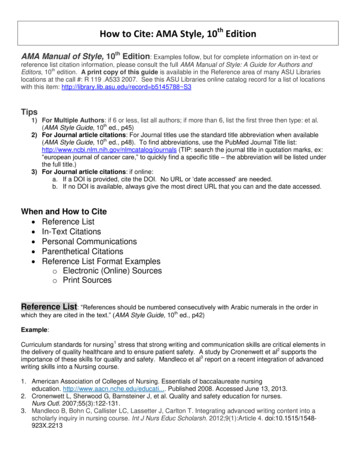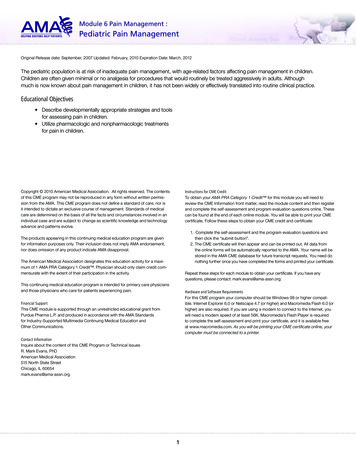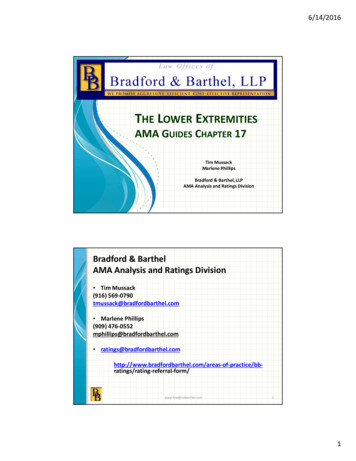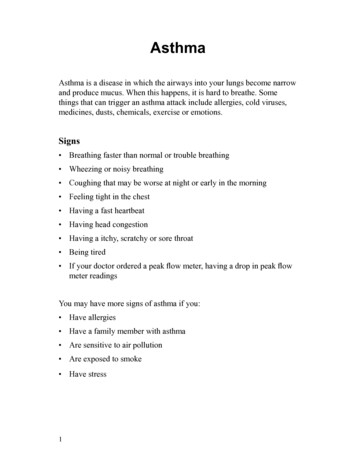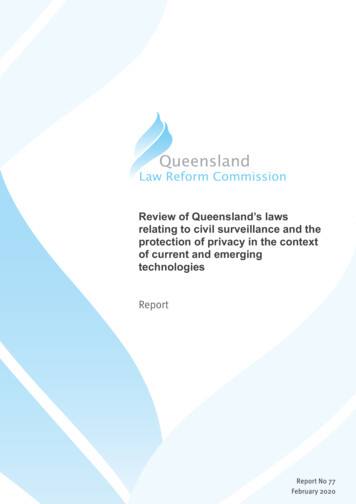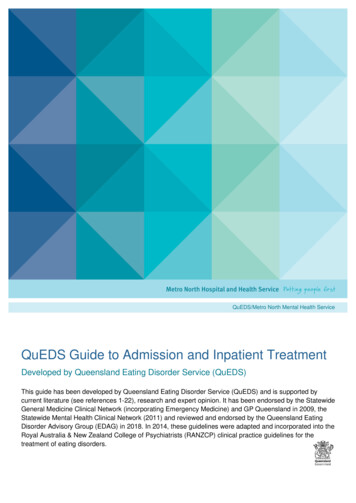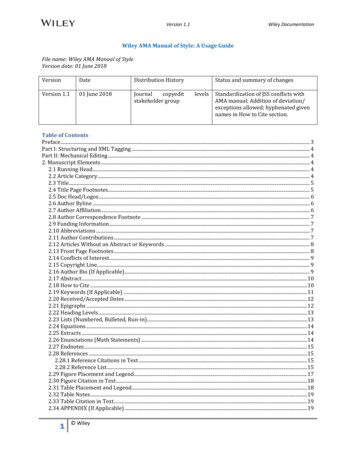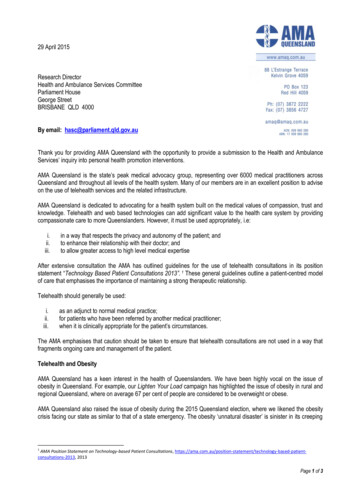
Transcription
29 April 2015Research DirectorHealth and Ambulance Services CommitteeParliament HouseGeorge StreetBRISBANE QLD 4000By email: hasc@parliament.qld.gov.auThank you for providing AMA Queensland with the opportunity to provide a submission to the Health and AmbulanceServices’ inquiry into personal health promotion interventions.AMA Queensland is the state’s peak medical advocacy group, representing over 6000 medical practitioners acrossQueensland and throughout all levels of the health system. Many of our members are in an excellent position to adviseon the use of telehealth services and the related infrastructure.AMA Queensland is dedicated to advocating for a health system built on the medical values of compassion, trust andknowledge. Telehealth and web based technologies can add significant value to the health care system by providingcompassionate care to more Queenslanders. However, it must be used appropriately, i.e:i.ii.iii.in a way that respects the privacy and autonomy of the patient; andto enhance their relationship with their doctor; andto allow greater access to high level medical expertiseAfter extensive consultation the AMA has outlined guidelines for the use of telehealth consultations in its positionstatement “Technology Based Patient Consultations 2013”. 1 These general guidelines outline a patient-centred modelof care that emphasises the importance of maintaining a strong therapeutic relationship.Telehealth should generally be used:i.ii.iii.as an adjunct to normal medical practice;for patients who have been referred by another medical practitioner;when it is clinically appropriate for the patient’s circumstances.The AMA emphasises that caution should be taken to ensure that telehealth consultations are not used in a way thatfragments ongoing care and management of the patient.Telehealth and ObesityAMA Queensland has a keen interest in the health of Queenslanders. We have been highly vocal on the issue ofobesity in Queensland. For example, our Lighten Your Load campaign has highlighted the issue of obesity in rural andregional Queensland, where on average 67 per cent of people are considered to be overweight or obese.AMA Queensland also raised the issue of obesity during the 2015 Queensland election, where we likened the obesitycrisis facing our state as similar to that of a state emergency. The obesity ‘unnatural disaster’ is sinister in its creeping1AMA Position Statement on Technology-based Patient Consultations, ased-patientconsultations-2013, 2013Page 1 of 3
approach and risks crippling our health system in the future. By 2020, Queensland Health estimates that three millionQueenslanders are expected to be overweight or obese.2This is one of the reasons why AMA Queensland has developed our Health Vision, which we released on 17 April,2015. We have attached a copy of the Health Vision for the information of the committee. The Health Vision outlines anumber of initiatives designed to help overweight and obese Queenslanders become five percent slimmer by 2020.One of the initiatives suggested in the Health Vision, which is of direct relevance to the terms of reference of thecommittee’s inquiry, is the use of telehealth services to combat obesity. We believe there is value in Queensland Healthestablishing a multidisciplinary team comprised of dieticians, exercise physiologists and specialist bariatric serviceswhose primary purpose is to consult on chronically obese patients. Based in Brisbane, this team would be availablestate-wide to help consult on patients who have been referred to the service by their regular GP and who need someextra help losing weight.There is a large evidence base to support the use of telehealth services in combating overweight and obesity 3. Oneparticularly interesting example comes from researchers at the University of California, Los Angeles (UCLA) workingwith overweight and obese pediatric patients set up a pilot program using telehealth technology in which they reviewedthe patients' vitals and blood test results, asked questions about the patient's health and lifestyle, and worked withpatients to set healthy lifestyle goals. Their study of the program found approximately 80 percent of patients weresatisfied with their telehealth appointment, saying they felt comfortable and that their privacy was protected.4Through the initiatives outlined in the Health Vision, AMA Queensland believes that overweight and obeseQueenslanders could be, on average, up to 5 per cent slimmer by 2020. We note that the terms of reference of yourenquiry asks the committee to seek opportunities to partner with other organisations to promote health and well-beingthrough innovative use of information and communication technologies. We would welcome the opportunity to providethe committee with a further briefing on the Health Vision and how it could factor into this task.Telehealth Cost EffectivenessTelehealth in Queensland has been an area of heavy investment for some time and there have been notablesuccesses, both in terms of patient outcomes and cost-savings to the system.AMA Queensland strongly supports innovative use of telehealth in providing better services and outcomes toQueensland patients. A prime example is the teleonocology service run from Townsville which has reduced costs forpatients and the health system, reduced stressful travel for patients, while maintaining clinical outcomes5.Also of note are: The Telepaediatric Service run through The University of Queensland, Centre for Online Health; Provision of mental health services through telemedicine; Retrieval Services Queensland which provides statewide support for the process of referral for aeromedicaltransfer of patients.These success stories illustrate the gains that can be made from the appropriate use of telehealth services to enhancethe care that patients can receive locally and give access to more highly specialised care.However, evidence provided in a previous Parliamentary enquiry into telehealth revealed that telehealth equipment iscurrently used on average twice a week, for a total per month average of 8.9 hours6. From this it is evident that the use2Queensland Chief Health Officers Report 2014: http://www.health.qld.gov.au/cho report/Royer, S, The Evidence base for telehealth and telemedicine in the management of obesity, http://bit.ly/1EltIDy, July 20114Albin, A, Pilot program study finds that pediatric obesity patients like telehealth services, http://bit.ly/1zm00iW, December 20115Darshit A Thaker, Richard Monypenny, Ian Olver and Sabe Sabesan. Cost savings from a telemedicine model of care in northern Queensland,Australia. Med J Aust 2013; 199 (6): 414-4173Page 2 of 3
of telehealth could be expanded. The challenge for Queensland Health will be to translate these early gains andinnovative models of care into mainstream practices in a way that provides safe and high-quality care, appropriatetraining for clinicians and is cost effective for the system.ConclusionAMA Queensland believes that telehealth is an important tool that can be used to help alleviate pressures on themedical workforce, increase health system capacity and improve patient outcomes for the better. We believe that theinvestment in telehealth infrastructure to date has been largely appropriate however this investment could bestrengthened and expanded upon. However, expansion of services will require greater levels of planning and supportfrom the Department of Health and high levels of engagement with clinicians at both the central and satellite locations.If you require further information in regards to this matter, please do not hesitate to contact Mr Leif Bremermann, PolicyAdvisor, AMA Queensland on 3872 2203.Yours sincerelyDr Shaun RuddPresidentAustralian Medical Association Queensland6Public Briefing – Inquiry into Telehealth Services in Queensland, Transcript of Proceedings. 5 March 2014. Health and Community ServicesCommittee, Queensland Parliament: Brisbane. Evidence of Mr Bryett, p4.Page 3 of 3
AMA Queensland’sHealth VisionPart One: Public Health and Generational Disadvantage
ExecutiveSummaryAMA Queensland is proud to launch Part One of its Health Vision, thefirst of five documents that will guide our advocacy and policy efforts overthe course of the next five years.This first chapter examines the topic of public health, but future sectionswill focus on other topics such as; workforce and training issues affectingour medical workforce; end of life care; reprioritising care in response tochanging demand and; unifying the health system.It is appropriate that the Health Vision begins by examining the topic ofPublic Health, an issue of vital importance in ensuring Queenslanderslive healthy, productive lives. Sadly, growing health inequality andunhealthy lifestyles in both Queensland and Australia, especially inchildren, and an ageing population are increasing problems that arejeopardising the ability of our health care system to provide adequatecare for Queenslanders.Children make up 19 percent of Australia’s total population 1, but they are100 per cent of Australia’s future. This is why the Health Vision aims toensure that in five years time a child who was born today will be healthierand be best placed to live longer than a child born earlier. We believe thiscan be done by implementing the following initiatives.A Whole of Government Public Health Plan: By 2020, Queenslandwill have a whole of Government public health plan that will oversee allof the Government’s efforts to combat obesity, smoking, alcohol, mentalhealth and moreEscalating the fight against Obesity: Queensland Health estimatesthat three million Queenslanders are expected to be overweight orobese2 Like a flood or bushfire, obesity is a state emergency and shouldbe treated as such. By implementing a series of escalating responses tohelp Queenslanders lose weight, from fresh food initiatives to publiclyfunding bariatric surgery, we believe it is possible that overweight andobese Queenslanders will be, on average, five percent slimmer by 2020Recommit to Closing the Gap: Queensland’s commitment to Closingthe Gap has faltered in recent years. AMA Queensland will convene aworking group as part of the development of the Public Health Plan tohelp advise the Queensland Government on what is needed to helpQueensland meet its targets.Extra Measures to Improve Vaccination Rates: AMA Queenslandrecognises the effort that has been put into achieving Queensland’shigh vaccination levels and commends the release of the QueenslandImmunisation Strategy 2014-17, which contains a number of positivesolutions to increase immunization rates and combat misinformation.But more needs to be done to increase immunisation rates in areas withlow herd immunity. AMA Queensland is advocating for funding for amobile immunisation van in areas of low herd immunity and a targetedpatient transport plan to assist patients in travelling to and from theirappointments.AMA Queensland’s Health Vision draws on the experience of ourmembers and existing research in developing its recommendations. Webelieve that these targets are achievable and affordable and in manycases will help deliver savings to health resources.We hope to work collaboratively with Government and other stakeholderson the implementation of the AMA Queensland Health Vision over thenext five years and we commend this report to all who read it.1Australian Bureau of Statistics, Population by Age and Sex, Regions of Australia, 35.02 Queensland Health. The health of Queenslanders 2014. Fifth report of the Chief HealthOfficer Queensland. Queensland Government. Brisbane 2014.AMA Queensland’s Health Vision www.amaq.com.auwww.amaq.com.au21
Public health requires an organisedresponse to minimise illness, injuryand disability, and to protect andpromote health.public healthThe Problem:For too long now, Queensland has lacked a dedicated public healthpolicy. Although there have been policies that cover individual publichealth issues, such as smoking or obesity, there has been a distinctlack of a coordinated, overarching, whole-of-government policy thattackles the best way to manage public health in a state as large anddecentralised as ours. This has resulted in some significant wins, suchas Queensland’s higher than average vaccination rates, as well as somesignificant losses, such as our state’s growing obesity epidemic.Whereas there has been a large and commendable investment in healthinfrastructure and hospitals and attempts at addressing the healthworkforce crisis, the previous term of Government in Queensland sawsignificant cuts to public health funding programs which made the taskof treating public health problems all the more difficult.AMA Queensland’s Health Vision www.amaq.com.auAs defined by AMA’s public health position statement, public health3requires an organised response to minimise illness, injury and disability,and to protect and promote health. A strong public health policy ispredicated on the measurement and analysis of the burden of disease. Ina resource scarce environment, this analysis informs the decisions thatare made regarding which health activities/services are cost-effectivefor the population’s health.AMA Queensland believes the following areas of public health are ofparticular concern, and require special attention from Governmentwhen developing future public health policy.3 AMA Public Health Position Statement, -20063
Vaccination Rates:Aboriginal and Torres StraitIslander Public Health:Aboriginal and Torres Strait Islander health outcomes are among theworst in the developed world. It is for this reason that the Closing theGap program was initiated.The Close the Gap program has been a rare example of bipartisanship inAustralia, which is to be commended. It is because of this bipartisanship,and because of the dedication of many hard working medicalprofessionals around the country, that the Close the Gap initiative hasmanaged to achieve some important successes since it began in 2009,particularly in the health sphere such as the notable improvements ininfant mortality rates.However, it has also had some worrying failures. In the most recentClosing the Gap report, delivered by Prime Minister Tony Abbott in 2015,it was revealed the Aboriginal and Torres Strait Islander men and womenstill die, on average, around a decade younger than non-Aboriginal andTorres Strait Islander Australians.4 There are still 15 years to go until2030. Policy continuity and transparent reporting is critical for theachievement of health equality over that span of time.In recent years we have started to see a shift away from bipartisansupport of Closing the Gap toward implementing austerity measures.For example, in 2013 the Queensland Government has cut a numberof health services that were assisting to improve health outcomes inCape York and the Torres Strait, such as smoking cessation programsand women’s health. And in the 2014 Federal Budget, 165 million overfive years will be cut from Indigenous Health programs and redirectedto the Medical Research Future Fund.5 Further, the Budget did notmention any further funding for a National Partnership Agreement onIndigenous Health or investment for the National Aboriginal and TorresStrait Islander Health Plan.6 The 2015 Queensland election also all butignored Close the Gap and Aboriginal and Torres Strait Islander healthpolicy. When this is all considered together it paints a worrying picture,given that the Close the Gap initiative requires continued momentumto turn around Aboriginal and Torres Strait Islander health outcomes.Vaccinating against preventable disease is a proven method ofreducing the incidence of and deaths from diseases such as measles,tetanus, diphtheria, and Haemophilus influenza type B. Australia’scomprehensive vaccination program means that the occurrence ofvaccine-preventable diseases (VPD) is now very rare 7. This, coupled withsubstantially improved vaccination rates in the last 20 years 8, meansAustralia has an excellent record of achievement in the prevention ofdisease through immunisation.Unfortunately there are some sections of society who believe, wrongly,that immunisation is dangerous. Organisations that continue to peddleincorrect information about the safety and efficacy of vaccines arethreatening the herd immunity9 that vaccination rates require to beeffective. This is particularly the case in more affluent areas, such asthe Sunshine Coast which reports an 89.9% immunization rate, but isalso true in other parts of Queensland, such as the Torres Strait whichreports a worryingly low 85.7% rate.10 In an effort to turn this around,April 2014 saw Queensland Health introduce a 3 million incentive tohelp local Hospital and Health Services (HHS) boost immunizationrates. Any HHS that improves vaccination rates will be able to share inthe funding.11 There is currently no data to test the effectiveness of thisplan.Queensland Health, particularly its Chief Health Officer, deserve creditfor providing material to counter this claim and debunk the views putforth by vaccination skeptics. However, Queensland Health has alsobegun a trial of a scheme which allows pharmacists to administerinjections. AMA Queensland believes the Queensland PharmacyImmunisation Program (QPIP) is a poor and possibly dangeroussubstitute to vaccinations provided via a qualified medical practitioner.While immunisations are safe, there is always the possibility of anadverse reaction. Pharmacists lack the training and medical expertiseto handle adverse reactions, which could lead to potentially disastrousresults. Further, AMA Queensland believes that the QPIP fractures care,which is not an ideal situation. To help maintain Australia’s impressiverecord in vaccination schedules and to help combat the misinformationbeing peddled by skeptics’ networks, the community must be confidentin the safety and quality of immunisation services.AMA Queensland welcomes the release of the QueenslandImmunisation Strategy 2014-17, released in July 2014, which contains anumber of positive proposals to try and counter incorrect informationand increase vaccination rates12. However, the Strategy plans to expandthe QPIP, which AMA Queensland sees as a significant step backwards inimproving consumer confidence in the safety of the vaccination process.4 Department of Prime Minister and Cabinet. Closing the Gap: Prime Ministers Report2015. Commonwealth Government. Canberra 2015.7 The Australian Immunisation Handbook, 9th edition, Department of Health and Ageing,20085 Federal Budget Papers No.2, p.1858 Australia’s Health, Australian Institute of Health and Welfare, 20106 Reconciliation Australia. 2014-15 Federal Budget Summary, eral-budget-summary/, 2014.9 Herd immunity is a form of immunity that occurs when the vaccination of a significantportion of a population (or herd) provides a measure of protection for individuals whohave not developed immunity10 Springborg, L. 3 million incentive to boost vaccination rates. Queensland Government.Brisbane. 201411 ibid12 Queensland Health. Queensland Immunisation Strategy 2014-17. QueenslandGovernment. Brisbane. 2014AMA Queensland’s Health Vision www.amaq.com.au4
Overweight and Obesity:Rates of overweight and obesity are reaching pandemic levels inAustralia and Queensland. While this is a condition that can affectanyone, research shows that where you live can put you at greater riskof becoming overweight or obese. Households in low socio-economicareas have a greater prevalence of overweight or obese people. This canbe due to a number of factors, including the cost of fresh and healthyfood (which is often more expensive than less healthy options). This is asignificant concern as part of Generational Disadvantage, which will bediscussed in greater detail later in this chapter.Smoking:Queensland has recently enacted tough new smoking laws which bansmoking in indoor and outdoor public areas, as well as restrictionson the promotion, sale and display of tobacco products. This is tobe commended. Further, smoking rates appear to be decreasing byaround 4 per cent every year. And yet Queensland’s smoking rates arecomparatively still relatively high, with the third highest proportionof smokers (17%) behind the Northern Territory (24%) and Tasmania(22%)13. The latest Australian Health Survey reveals diseases of therespiratory system, such as lung cancer, are the most prevalent form ofdisease in Queensland.14Alcohol related harms:Currently Queensland lacks a focused policy on the responsibleconsumption of alcohol. It is also spread out across at least twoportfolios with no obvious cooperation between them. QueenslandHealth has the “Young Women and Alcohol” campaign, whereas theOffice of Liquor and Gaming Regulation (OLGR) handles laws aroundthe sale of alcohol, including the “Safe Night Out Strategy.” The OLGRalso regulates the sale of alcohol in several Aboriginal and Torres StraitIslander communities, a responsibility it shares with the Departmentof Aboriginal and Torres Strait Islander Partnerships and MulticulturalAffairs. Focus is needed to strengthen this area of public health concern.This lack of focus is arguably contributing to a sharp increase indangerous levels of alcohol consumption in Queensland. In 2009, 10.6%of persons, 11.9% of males and 9.2% of females, reported consuming13 Australian Bureau of Statistics, Australian Health Survey: First Results, tailsPage/4364.0.55.001201112?OpenDocument14 ibidAMA Queensland’s Health Vision www.amaq.com.aualcohol in quantities that placed them in risky or high risk categoriesfor harm in the long term.15 By 2011, this had increased to 22.7% of alladult Queenslanders drinking at dangerous levels, with 35.0% of malesand 10.6% of females respectively.16 This trend needs to be curtailed, notleast because drink driving is the number one contributor as a factor inapproximately 30 per cent of crashes in Queensland.17It is also a danger for unborn children. When a pregnant womanconsumes alcohol during pregnancy, the unborn child can developFoetal Alcohol Spectrum Disorder (FASD). This can lead to problemsincluding low birth weight, distinctive facial features, heart defects,behavioural problems and intellectual disabilities.18During the 2015 Queensland election, the Labor Party agreed to supportthe Queensland Coalition for Action on Alcohol (of which AMAQis a member) plan19 to change the culture of alcohol consumptionin Queensland. With the subsequent election of the PalaszczukGovernment, AMA Queensland will keep a watching brief on this issueso as to ensure action on alcohol fuelled violence is taken.Mental Health:Mental Health already constitutes a greater burden of disease than itattracts in budget spending – nation-wide it attracts only five per cent ofthe budget while causing 13 per cent of the overall disease burden.20 Themost recent data indicates Queensland continues to fall significantlybehind all other States including Western Australia, South Australia andTasmania in per capita expenditure on mental health. 2115. Queensland Health. Alcohol Consumption in Queensland 2009, http://www.health.qld.gov.au/atod/documents/2009 alcoconsumpqld.pdf16. Queensland Health. Alcohol Consumption in Queensland 2011, s/alcohol-2011-fs.pdf17. Centre for Accident Research and Road Safety. State of the Road: Drink DrivingFactsheet, aigns/Documents/drink driving fs.pdf. 2012.18. Better Health Channel. Fetal Alcohol Spectrum Disorder (FASD), es.nsf/pages/Fetal alcohol spectrumdisorder?open, Victorian Government.19. Queensland Coalition for Action on Alcohol, Election Platform, http://www.qcaa.org.au/2015-election-platform/, 201520. Well meant or well spent? Accountability for 8 billion of mental health reform.Sebastian P Rosenberg, John Mendoza and Lesley Russell. Med J Aust 2012; 196 (3): 15916121. SCRGSP (Steering Committee for the Review of Government Service Provision) 2013, Report onGovernment Services 2013, Productivity Commission, Canberra, figure 12.35
Generational Disadvantage:A related issue to these concerns is that of generational disadvantage.Generational disadvantage refers to the situation in which multiplegenerations of the same family experience high and persisting levelsof social exclusion, material and human capital impoverishment, andrestrictions on the opportunities and expectations that would otherwisewiden their capability to make choices. 22There are considerable inequalities in health outcomes withinQueensland’s population. This is particularly the case for Aboriginaland Torres Strait Islanders, whose children are almost twice as likelyto die between the ages of 0-4 as non-Indigenous children. 23 But evenoutside of these communities, around the fringes of the Brisbane localgovernment area, there exist whole suburbs where anywhere betweentwo and four generations of children have grown up without a workingparent. 24It is likely that this is one of the many reasons that obesity is moreprevalent in low income areas. Research indicates that a healthy start inlife is vitally important, with obese or overweight children often growingto become obese or overweight adults.25 If entrenched poverty makes itdifficult to purchase healthy food and participate in healthy activities, itis understandable that this would be a contributing factor to Australia’sobesity epidemic.Research shows that smoking and poor mental health is also moreprevalent in areas where there are generally lower levels of income.It also shows alcohol consumption which exceeds the lifetime risk ofharm (more than two standard drinks on any day) is more prevalent inareas of higher income. This is true of both Aboriginal and Torres StraitIslander communities and non-Aboriginal and Torres Strait Islandercommunities. Young Australians growing up in disadvantage are morelikely to take a number of health (e.g. smoking, drinking, illicit druguse) or social risks (e.g. running away, coming into contact with police/courts) and to have health problems as they enter adulthood (e.g.asthma, depression).26AMA Queensland’s Health Vision www.amaq.com.auGenerational disadvantage is also having a long term negative effecton the health system and public health in general. Lack of affordableoral health care services in disadvantaged areas and remote areas ofQueensland is leading to higher hospitalisation rates for dental decay.This is a problem that should be prevented from occurring in the firstplace, or if treatment is needed it should be affordable and accessible inthe primary care setting.There is relatively little evidence that Queensland’s disjointed approachto public health policy over successive governments has taken intoaccount the well established fact that the socio-economic status of agiven area can have an impact upon public health.22. Hancock, K. Edwards, B. Zubrick, S.R. Echoes of disadvantage across the generations?The influence of long-term joblessness and separation of grandparents ongrandchildren, Longitudinal Study of Australian Children Annual statistical report, 201223. Queensland Council of Social Services, Addressing Poverty and Disadvantage inQueensland, http://bit.ly/1EX28iu, March 201324. Tanton, R. Gong, H. Harding, A. Multiple Generation Disadvantage. %20Generation%20Disadvantage.pdf, NationalCentre for Social and Economic Modelling. July 201125. Queensland Health. A Healthy Start in Life. il full doc.pdf, Queensland Government, Brisbane. 200826. Cobb-Clark, D. Disadvantage Across the Generations. http://insights.unimelb.edu.au/vol8/07 Cobb-Clark.html, University of Melbourne, Faculty of Business and Economics,20106
AMA Queensland wants to ensurethat a child born today will grow upin a Queensland that has a publichealth regime that ensures he orshe will have the best possible startin life.AMA Queensland’s Health Visionfor Public HealthAMA Queensland wants to ensure that a child born today will grow upin a Queensland that has a public health regime that ensures he or shewill have not only the best possible start in life, but also the best chanceof living a longer and healthier life. This means not only creating a publichealth policy that benefits the child, but his or her parents, too.A child born today will be five years old in 2020, and to achieve ourvision, AMA Queensland believes the following targets must be activelyworked towards during the next five years.AMA Queensland’s Health Vision www.amaq.com.au7
TARGETONEA Whole of Government PublicHealth PlanBy 2020, Queensland must have a whole of government public healthplan. It will be a coordinated plan to tackle some of Queensland’s biggesthealth challenges, such as smoking, obesity, diabetes, alcohol abuseand mental health. Addressing Queensland’s obesity emergency andchanging Queensland’s drinking culture should be given a particularlyhigh priority in this plan.AMA Queensland believes the ideal model for a Queensland PublicHealth plan is the South Australian State Public Health plan. Thedevelopment of the SA plan began in 2000 and has had cross-partysupport since that time, with successive Health Ministers from bothsides of politics continuing the development of the plan. This kind ofbipartisan support that transcends the three year electoral cycle is notonly rare, it is highly commendable, and AMA Queensland believes thatif South Australia can do it, there is no reason Queensland can’t do thesame.The SA plan coordinates the actions of a
funding bariatric surgery, we believe it is possible that overweight and obese Queenslanders will be, on average, five percent slimmer by 2020 Recommit to Closing the Gap: Queensland's commitment to Closing the Gap has faltered in recent years. AMA Queensland will convene a working group as part of the development of the Public Health Plan to


